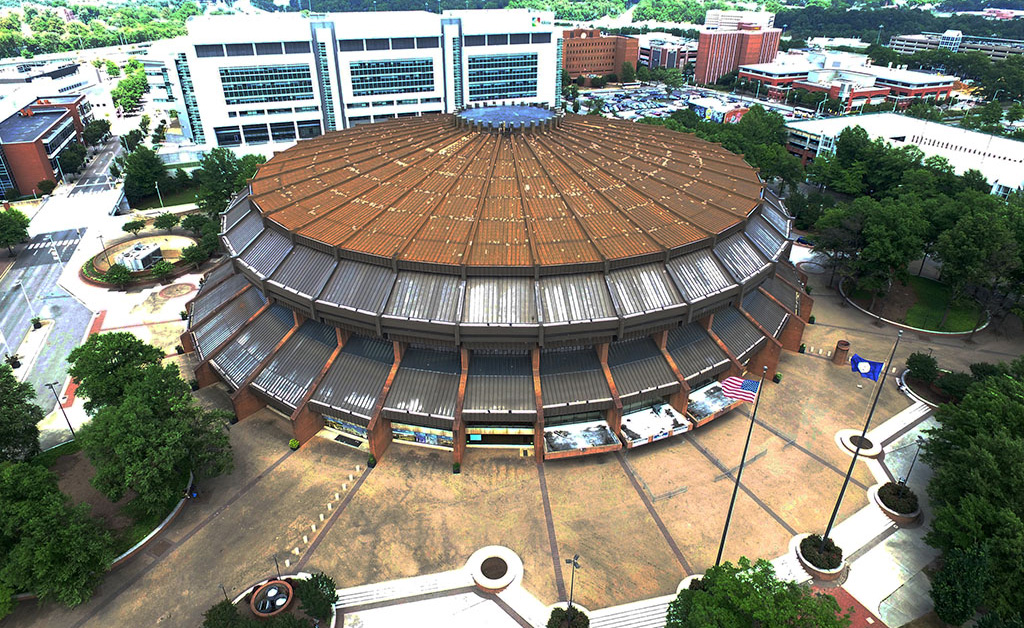
The Richmond Coliseum will be demolished but a local attorney would like to see part of it used for an amphitheater. (BizSense file)
By Stefan Calos
My first installment on this topic generated a lot of interest.
Under the preliminary plan outlined by the City of Richmond, the Coliseum would be demolished. An open space for outdoor gatherings, with a parking garage underneath, would take the place of the building.
My point remains that such a space could include part of the existing structure. The concrete amphitheater resulting from simply leaving the lower level of seating would hold several thousand spectators.
It could be used for all kinds of outdoor gatherings, including graduation ceremonies, concerts, and other live performances. Basketball could still be part of the equation, with room for more than one court to be used by area youth for pick-up games. An outdoor rink — with real or synthetic ice — could pay active homage to the Coliseum’s rich hockey and skating history.
Comments about the idea of leaving some of the seating and perhaps some other structural elements of the existing building ranged from full support, to skepticism and outright rejection. Commentators ranged from interested citizens, to architects and other professionals.
Questions and concerns were raised as to potential demand for use of the space, drainage, parking, and costs. Some seemed to think I was advocating only for full restoration of the building. But based on the city’s preliminary plan, I harbor no illusions that the Richmond Coliseum will be restored.
So, in addressing comments, my focus is on the amphitheater that would remain after the bulk of the building is demolished:
Build it — or more precisely, leave a piece of it — and they will come. Folks in RVA love graduations, concerts, basketball, skating, and all things outdoors. They will come to the amphitheater.
We have the technology to make sure the amphitheater stays an amphitheater, and doesn’t become an inadvertent swimming pool when it rains. The home of canal locks and flood walls knows a thing or two about diverting water. We’ve got this, too.
Parking will only improve. The amphitheater will seat far fewer than the Coliseum. If we need more parking for other reasons, there is plenty of truly vacant land nearby for that.
There are no costs to build the amphitheater itself. It already exists. It just needs to be exposed. That will happen when the Coliseum building is demolished. And demolition costs will not go up, because the City had already planned to remove the debris from the site to fill the lower level seating area with a parking garage.
I hope what happened in my hometown doesn’t happen here. Our elementary school had an amphitheater that was built in the 1930s under the WPA. Decades later, the developer of an adjacent construction project asked permission to deposit along the side of the amphitheater “a little dirt” from excavation.
A little dirt apparently goes a long way, because the amphitheater has been completely covered in the decades since. Now another developer is seeking to locate and dig out the amphitheater, as a focal point of a new housing community near the site. Talk about unnecessary expense.
Think of the positive media coverage the grand opening of Richmond’s “new” amphitheater could garner. The City would be viewed nationwide as a leader in adaptive reuse.
I say we invite Julius Erving to the grand re-opening of the courts where his fabulous pro basketball career began. He is closer to 70 than 20 now, but last time I checked “Dr. J” could still dunk. What a grand opening that would make.
• Stefan Calos is a shareholder at Richmond law firm Sands Anderson, where he is also chair of the commercial real estate team.
To submit a guest opinion to BizSense, please email opinions@richmondbizsense.com. And click here to read more about the criteria for submission.

The Richmond Coliseum will be demolished but a local attorney would like to see part of it used for an amphitheater. (BizSense file)
By Stefan Calos
My first installment on this topic generated a lot of interest.
Under the preliminary plan outlined by the City of Richmond, the Coliseum would be demolished. An open space for outdoor gatherings, with a parking garage underneath, would take the place of the building.
My point remains that such a space could include part of the existing structure. The concrete amphitheater resulting from simply leaving the lower level of seating would hold several thousand spectators.
It could be used for all kinds of outdoor gatherings, including graduation ceremonies, concerts, and other live performances. Basketball could still be part of the equation, with room for more than one court to be used by area youth for pick-up games. An outdoor rink — with real or synthetic ice — could pay active homage to the Coliseum’s rich hockey and skating history.
Comments about the idea of leaving some of the seating and perhaps some other structural elements of the existing building ranged from full support, to skepticism and outright rejection. Commentators ranged from interested citizens, to architects and other professionals.
Questions and concerns were raised as to potential demand for use of the space, drainage, parking, and costs. Some seemed to think I was advocating only for full restoration of the building. But based on the city’s preliminary plan, I harbor no illusions that the Richmond Coliseum will be restored.
So, in addressing comments, my focus is on the amphitheater that would remain after the bulk of the building is demolished:
Build it — or more precisely, leave a piece of it — and they will come. Folks in RVA love graduations, concerts, basketball, skating, and all things outdoors. They will come to the amphitheater.
We have the technology to make sure the amphitheater stays an amphitheater, and doesn’t become an inadvertent swimming pool when it rains. The home of canal locks and flood walls knows a thing or two about diverting water. We’ve got this, too.
Parking will only improve. The amphitheater will seat far fewer than the Coliseum. If we need more parking for other reasons, there is plenty of truly vacant land nearby for that.
There are no costs to build the amphitheater itself. It already exists. It just needs to be exposed. That will happen when the Coliseum building is demolished. And demolition costs will not go up, because the City had already planned to remove the debris from the site to fill the lower level seating area with a parking garage.
I hope what happened in my hometown doesn’t happen here. Our elementary school had an amphitheater that was built in the 1930s under the WPA. Decades later, the developer of an adjacent construction project asked permission to deposit along the side of the amphitheater “a little dirt” from excavation.
A little dirt apparently goes a long way, because the amphitheater has been completely covered in the decades since. Now another developer is seeking to locate and dig out the amphitheater, as a focal point of a new housing community near the site. Talk about unnecessary expense.
Think of the positive media coverage the grand opening of Richmond’s “new” amphitheater could garner. The City would be viewed nationwide as a leader in adaptive reuse.
I say we invite Julius Erving to the grand re-opening of the courts where his fabulous pro basketball career began. He is closer to 70 than 20 now, but last time I checked “Dr. J” could still dunk. What a grand opening that would make.
• Stefan Calos is a shareholder at Richmond law firm Sands Anderson, where he is also chair of the commercial real estate team.
To submit a guest opinion to BizSense, please email opinions@richmondbizsense.com. And click here to read more about the criteria for submission.




Sure would beat anything else new this administration will come up with, and re-use is always a hard sell. Wouldn’t it be great if the old Huguenot bridge was kept as a pedestrian crossing/park?
That´s a good idea.
A proposal worth considering. Innovative solutions will come from the Richmond community not the insular Richmond political leadership. Let’s reuse and readapt whenever possible. Richmond has a pretty poor track record when “chasing the new”. Richmond’s history and heritage are a huge part of our identity and charm.
Some may not like this but here’s my opinion… There’s no way that this could happen in Richmond. The city government would screw this up so badly – specifically with regards to costs. The article states that there would are no costs to build the ampitheater itself. If it were to be re-purposed, the City of Richmond government would find some way to screw that up and cost the taxpayers a fortune. They have done this with every project they have ever been involved in. That’s if the project got approved – speaking of which… A project like this would… Read more »
You’re correct. No study needs to be funded to approve a musical/cultural venue. When the Coliseum wasn’t a dump, we had good concerts here. We can no longer attract or book them. It’s a shame that the closest places we can go see a top billing artist is Virginia Beach (traffic!!) or Charlottesville. Bring concerts back to RVA!
Henrico (Green city) will be great
The cost of an appropriate drainage solution alone would be in the millions – then you have to remember that this concrete was never sealed for outdoor use, a process I’m sure the city would over-pay for. I’d imagine people would want some sort of cover for inclement weather, like Strawberry Hill had (has?) which would have its own maintenance costs. I actually really like this concept, but pretending that it would be free isn’t going to help anyone.
Thank you.
The better move would be for the city to sell off the property to private developers (and not transfer the site to the state) – at least the city would get some kind of monetary return for the property – and a private developer can come in — at no cost to the taxpayer — and develop/redevelop the site. Personally, I would far rather see high-density, high-rise residential development built throughout that swath of blocks north of Broad. The idea of an amphitheater is compelling – and perhaps in a different/better location would be a real plus for downtown. Without… Read more »
One wonders why a developer would want to do that, if the asset they are covering up is so valuable. To the reply of ¨don´t worry, we have the tech to make sure drainage is okay¨ — the obvious counter-reply is ¨of course. We also have the tech to make it into another Dubai skyscraper or a dirigible mooring — but what will be the ROI for such a project — invoking the shokoe drainage projects or floodwalls makes one a bit queasy, if one thinks they will have to help pay for it. Again, I am not necessarially opposed,… Read more »
PS, I am not saying that drainage would be an issue, but if it is an issue, anyone who brushes the issue off is not on the side of the taxpayers.